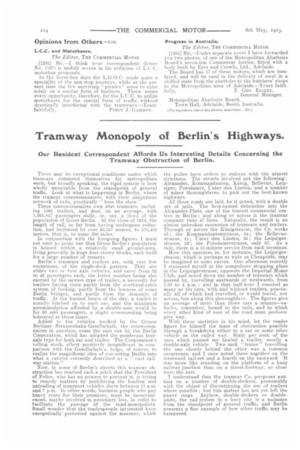Tramway Monopoly of Berlin' s Highways.
Page 22

If you've noticed an error in this article please click here to report it so we can fix it.
Our Resident Correspondent Affords Us Interesting Details Concerning the Tramway Obstruction of Berlin.
There may be exceptional conditions under %%inch tramcars commend themselves for metropolitan work, but broadly speaking, the rigid system is here wholly unsuitable from the standpoint of general traffic. Look at what is happening in Berlin, where the tramcar coneessionnaires, with their ubiquitous network of rails, practically " boss the show."
These concessionnaires own 284S tramcars, including 1091 traders, and deal, on an average, with 1,265,847 passengers daily, or, say, a third of the population of Gross-Berlin. At the close of 1912, the length of rail, so far from having undergone reduction, had increased by over 25,357 metres, to 570,483 metres, that is, to some 256 miles.
In conjunction with the foregoing figures I must not omit to point out that Gross-Berlins population is housed within a relatively small ground-area, living generally in huge four-storey blocks, each built for a large number of tenants. Berlin's tramcars and trailers are, with very few exceptions, of the single-deck pattern. They are either two or four axle vehicles, and carry from 32 to 46 passengers each, the latter number being also carried by the newest type of trailer, a necessity for trailers having risen partly from the overhead-cable system of feeding, partly from the lowness of some Berlin bridges, and partly from the demands of traffic. At the busiest. hours of the day, a trailer is usually hitched on to each car, and the maximum accommodation afforded by a double-unit would he for 90 odd passengers. a slight overcrowding being tolerated at these times.
Added to the vehicles worked by the Grosse Berliner Strassenbahn-Gesellschaft, the concessionmires in question, come the cars run by the Berlin Corporation, which has adopted the ponderous fouraxle type for both car and trailer. The Corporation's rolling stock. albeit positively insignificant in. comparison with the Gesellsehaft's, helps, of course, to realize the magnificent idea of converting Berlin into what a satirist correctly described as a " vast railway-station."
Now, in some of Berlin's streets this tramcar obstruction has reached such a pitch that the President of Police, who has no powers to prevent it, is trying to remedy matters by prohibiting the loading and unloading of transport vehicles there between 11 a.m. and 7 p.m. In other words, business people who pay heavy rents for their premises, must he inconvenienced, maybe involved in pecuniary loss, in order to facilitate the passage of the road-monopolists. Small wonder that the tradespeople interested have energetically protested against the .measure, which
the police have orders to enforce with the utmost strictness. The streets involved are the following: Alexander, Kommandanten, lionig, Bellevue, Leipziger, Potsdarner, Unter den Linden, and a number of minor thoroughfares, to pick out the best-known highways.
All these roads are laid, he it noted, with a double set of riails. The first-named debouches into the Alexander-Platz, one of the busiest commercial centres in Berlin ; and along or across it the tramcar company runs 47 lines. Naturally, the result is an almost unbroken succession of tramcars and trailers. Through or across the Konigstrasse, the Co. works 43; the Kommandantenstrasse, 34; the Bellevuestrasse, 41; Unter den Linden, 30; the Leipzigerstrasse, 52 ; the Potsdamerstrasse, only 57. As a rule, there is a 15-minute service from each terminus.
How this operates in, for instance, the Leipzigerstrasse, which is perhaps as wide as Cheapside, may be imagined to some extent. One afternoon recently I stationed myself at the compulsory stopping place in the Leipzigerstra.ss.e, opposite the Imperial Motor Club, and noted down the number of tramcars which passed by, travelling eastwards or westwards, from 3.30 to 4 p.m. ; and in that half-hour I counted as many as lot cars, with and without trailers, practically all of which had travelled, or would travel, not across, but along this thoroughfare. The figures give an average of more than three cars a minute—vehicles, remember, bound to the rails, and to which every other kind of user of the road must perforce give way.
With these statistics in his mind, let the Teader figure for himself the mass of obstruction possible through a breakdown either to a ear or some other vehicle on the railed way. Sixty per cent. of the ears which passed me hauled a trailer, mostly a double-axle vehicle. Two such "trains" travelling the one closely behind the other was a common occurrence, and I once noted three together on the westward rail-set and a fourth on the eastward. It was more like standing on the platform of a busy railway-junction than on a street-footway, so close were the cars.
I understarui that the tramcar Co. purposes putting on a number of double-deckers, presumably with the object of discontinuing the use of trailers where possible ; but this matter has not yet left the paper stage. Anyhow, double-deckers or doubleunits, the rail-system in a busy city is a nuisance from the standpoint of general traffic, and Berlin Presents a fine example of how other traffic may be hampered,


























